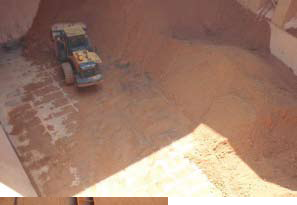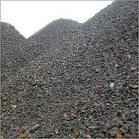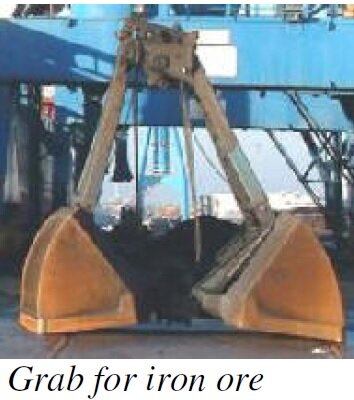
Fig: Discharging iron ore -final stage
When loading any of these iron ore products, care should be taken to monitor the temperature of the cargo itself whether it is in pellet, lump or briquette form. If the temperature exceeds 65°C, it must not be loaded onboard. The alternate option is that the shipper's declaration provides information as to whether the cargo has been sufficiently treated for oxidation/ corrosion inhibition to avoid any chance of spontaneous combustion on increase in the moisture content.
Blended iron-ore
Blended iron-ore containing DRI (C) can be identified by its chemical composition, which must include: total iron (Fe) content; metallic iron (Feo) content; and moisture content. The information must be supported by a certificate from an independent testing laboratory and be related to the cargo offered for shipment. The certificate should state the method and standards followed when obtaining the tested samples (preferably ISO 10835) and when determining the metallic iron content (preferably ISO 5416).
If a blended iron-ore cargo contains any metallic iron it should be regarded as DRI (C) and carried in accordance with the IMSBC Code.
Problem with Mill Scale
Mill Scale, a by product of hot rolled steel-making, is a bulk commodity liable to liquefaction, like iron ore fines. Mill Scale and Mill Scale Fines possess a transportable moisture limit (TML) and have thus been confirmed as Group A cargoes, which should not be accepted for loading without the shipper having certified the moisture content and TML. Due to the high density of the cargo, the IMSBC Code requires that it should be trimmed flat for the voyage, distributing the weight evenly over the tank top - wet base cargoes are prone to shifting, as the bottom liquefies and the top of the stow becomes free to slide over the base.
More topics on iron ore
Related Information
-
Hazards of handling copper concentrate
-
Hazards of handling bulk sulphur
-
Procedure for fishmeal loading in bulk
-
Loading, carrying and discharging of bulk coal
-
Special precaution & IMSBC code guideline for handling bulk coal
-
Special arrangements for carrying grain cargo
-
Grain handling precautions - various limitations
-
Salt loading guideline - Precautions & hold preparation
-
Pig iron preparations for bulk loading
-
Risk of iron ore liquefaction during sea passage & countermeasures
-
Preparations, loading, carrying & discharging bulk cement
-
Petcoke loading in bulk & associated problems for bulk carriers
-
Handling of bauxite - The environmental impact of Jamaica bauxite mining
-
Carrying gypsum -Toxins, physical reactions & environmental degradation
-
Cargo liquefaction & potential problem for transporting bulk cargo
Our detail pages illustrated many safety aspects of Bulk carrier
Home page |||Bulk carrier types ||| Handling of bulk coal |||Cargo planning ||| Carriage of grain |||Risk of iron ores |||Self unloading bulk carriers |||Care of cargo & vessel |||Cargoes that may liquefy |||Suitability of ships |||Terminal guideline |||Hold cleaning |||Cargo cranes |||Ballast handling procedure |||Bulk carrier safety |||Fire fighting systems |||Bulk carrier General arrangement
Related info
Additional articles
- Cargo information required by ship master prior handling bulk cargo
- Care of cargo during loading- Trimming pours
- Checklist for confirming stabilty and hull stress prior loading
- Cargo loading agreement between ship and terminal
- Bulk carrier loading manual
- Handling of deballasting (ship duties) during high loading rate
- Cargo and ballast handling guide
- Responsibility of ship during cargo operation
- Shipboard hazards & bulk carriers safety guideline
- Asymmetric cargo and ballast distribution for bulk carriers
- Limitations on exceeding load lines
- Risk of deviation from the loading limitations
- Cargo handling guidance for deck officers

Operation of sea going bulk carriers involved numerous hazards . Careful planning and exercising due caution for all critical shipboard matters are important . This site is a quick reference to international shipping community with guidance and information on the loading and discharging of modern bulk carriers so as to remain within the limitations as specified by the classification society.
It is vital to reduce the likelihood of over-stressing the ship's structure and also complying with all essential safety measures for a safe passage at sea. Our detail pages contain various bulk carrier related topics that might be useful for people working on board and those who working ashore in the terminal. For any remarks please Contact us
Copyright © 2010 bulkcarrierguide.com All rights reserved.
Although every effort have been taken to improve the accuracy of content provided the publisher of this website cannot take responsibility for errors. Disclaimer Privacy policy Home page


